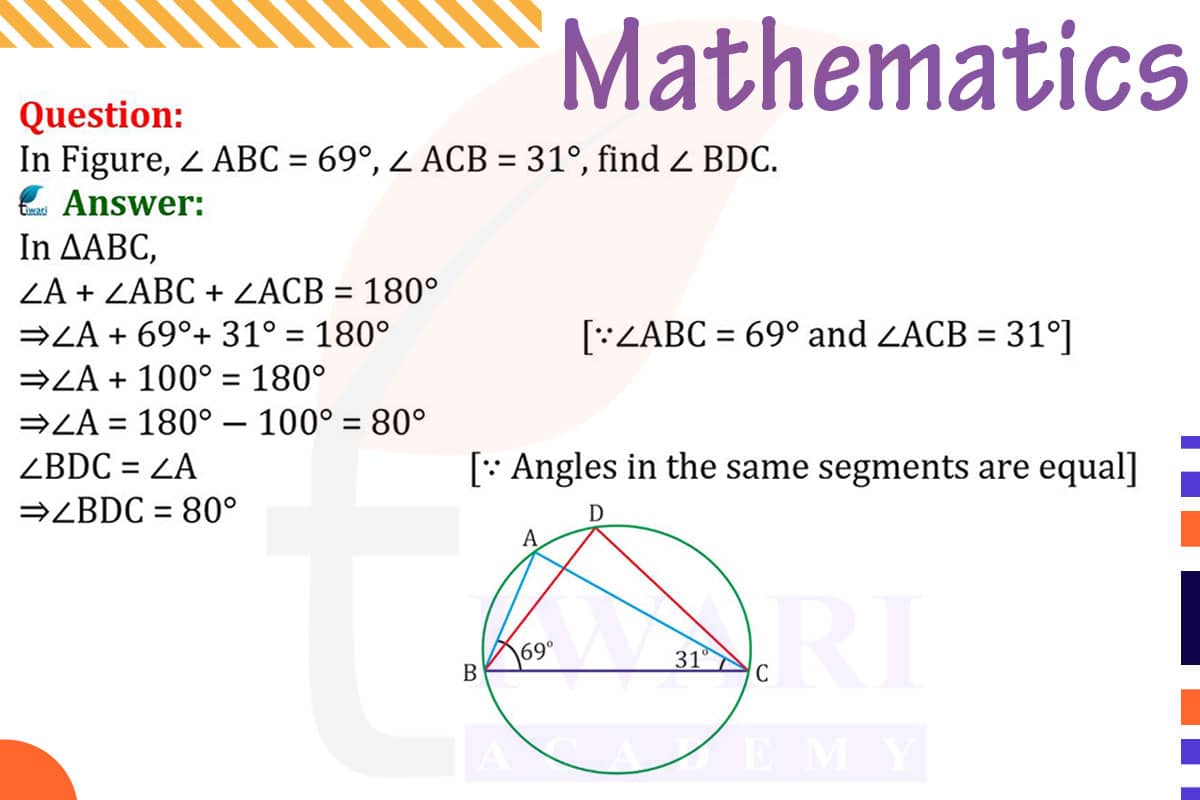In a cyclic quadrilateral ABCD, where ∠ABC = 69° and ∠ACB = 31°, we can find ∠BDC using the properties of cyclic quadrilaterals.
In a cyclic quadrilateral, the opposite angles are supplementary, meaning they add up to 180°. Since ∠ACB = 31°, this angle is part of triangle ABC which is inscribed in the circle. The angle ∠ACB is subtended by the same arc as angle ∠ADB (the angle at the opposite side of the circle). Therefore, ∠ADB = 31°.
Since ∠ADB and ∠BDC are opposite angles in cyclic quadrilateral ABCD, ∠BDC = 180° – ∠ADB = 180° – 31° = 149°.

Let’s discuss in detail
Cyclic Quadrilaterals and Angle Relationships
In the study of circle geometry, cyclic quadrilaterals offer fascinating insights into angle relationships. A cyclic quadrilateral is a four-sided figure with all its vertices lying on the circumference of a circle. In such a quadrilateral, certain angle properties hold true, which are crucial for solving problems like the one at hand. We are given a cyclic quadrilateral ABCD with angles ∠ABC = 69° and ∠ACB = 31°, and our task is to find the measure of ∠BDC.
Understanding the Properties of Cyclic Quadrilaterals
One of the key properties of cyclic quadrilaterals is that the sum of each pair of opposite angles is 180°. This supplementary relationship is a direct consequence of the quadrilateral’s vertices lying on a circle. This property will be instrumental in determining the unknown angle ∠BDC in quadrilateral ABCD.
Analyzing Triangle ABC within the Cyclic Quadrilateral
In the cyclic quadrilateral ABCD, triangle ABC is a critical component. The given angles, ∠ABC = 69° and ∠ACB = 31°, belong to this triangle. Since triangle ABC is inscribed in the circle, the angle ∠ACB is subtended by arc AD. This subtended angle relationship is vital for understanding the angles formed at other points on the circle.
Determining Angle ∠ADB
The angle ∠ACB (31°) in triangle ABC subtends the same arc as angle ∠ADB in the cyclic quadrilateral. Since these angles are subtended by the same arc, they are equal. Therefore, ∠ADB, which is the angle at the opposite side of the circle from ∠ACB, is also 31°. This equality is a direct application of the angle subtended by the same arc theorem in circle geometry.
Calculating Angle ∠BDC
With ∠ADB determined as 31°, we can now calculate ∠BDC. Since ∠ADB and ∠BDC are opposite angles in the cyclic quadrilateral ABCD, and opposite angles in a cyclic quadrilateral are supplementary, ∠BDC equals 180° – ∠ADB. Therefore, ∠BDC = 180° – 31° = 149°. This calculation is based on the supplementary nature of opposite angles in a cyclic quadrilateral.
Geometric Principles in Cyclic Quadrilaterals
In conclusion, by applying the properties of cyclic quadrilaterals and the theorem of angles subtended by the same arc, we find that ∠BDC in the cyclic quadrilateral ABCD is 149°. This exercise demonstrates the elegance and interconnectedness of geometric principles, particularly in the context of cyclic quadrilaterals. Understanding these relationships allows for a deeper appreciation of geometry’s role in elucidating spatial relationships and solving complex problems.
Discuss this question in detail or visit to Class 9 Maths Chapter 9 for all questions.
Questions of 9th Maths Exercise 9.3 in Detail


